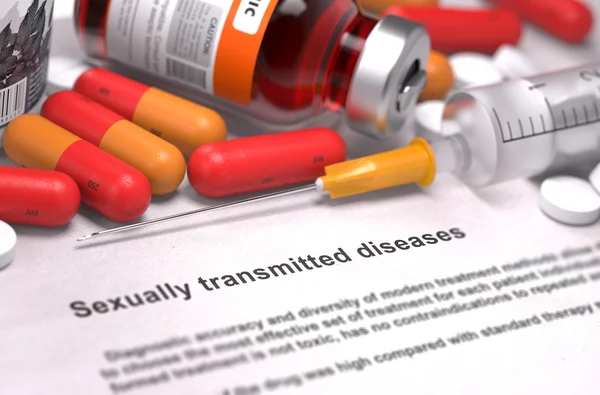Introduction:

Sexually Transmitted Diseases (STDs) are a group of infections that are primarily transmitted through sexual contact. These diseases pose a significant public health challenge worldwide, affecting millions of individuals each year. Understanding the complexities of STDs, learn about transmission modes, associated risks, prevention strategies, available treatments, and the vital role of healthcare providers in combating these infections, ensuring a comprehensive understanding for prevention and awareness.
I. What are Sexually Transmitted Diseases ?
STDs are caused by bacteria, viruses, or parasites that are transmitted through sexual activity, including vaginal, anal, or oral sex. Common types of STDs include Chlamydia, Gonorrhoea, HIV/AIDS, Herpes, Syphilis, HPV, Hepatitis B, and Trichomoniasis.
II. How are STDs Transmitted?
- Sexual Transmission Routes: a. Vaginal Intercourse: Penile-vaginal sexual contact without protection. b. Anal Intercourse: Penile-anal sexual contact without protection. c. Oral Sex: Mouth-genital or mouth-anal contact without protection.
- During pregnancy, childbirth, or breastfeeding, mothers can transmit STDs to their children, with HIV, Syphilis, and Hepatitis B being particularly relevant. Additionally, non-sexual transmission of STDs occurs through activities such as sharing contaminated needles or syringes during blood transfusions and injecting drugs with contaminated needles or equipment.
III. Risks and Consequences of STDs
- Physical Health Risks: STDs can lead to various complications, including: a. Pelvic Inflammatory Disease (PID): Inflammation of the female reproductive organs, potentially causing infertility. b. Chronic Pelvic Pain: Persistent pain in the pelvic region. c. Ectopic Pregnancy: Implantation of a fertilized egg outside the uterus. d. Cervical Cancer: Caused by certain strains of HPV. e. Liver Damage: Hepatitis B and C can cause liver inflammation and cirrhosis. f. Weakened Immune System: HIV/AIDS weakens the immune system, making individuals more susceptible to infections and certain cancers.
- Long-term Complications: Some STDs, if left untreated, can result in long-term complications, including chronic pain, organ damage, reproductive issues, increased risk of other infections, and certain cancers.
- Psychological and Social Implications: Sexually Transmitted Diseases can have a significant impact on mental health and personal relationships, leading to stigma, anxiety, depression, social isolation, and difficulties in intimate relationships.
IV. STD Prevention Methods:
A. Abstinence: Abstinence from sexual activity is the most effective way to prevent STD transmission.
B. Safe Sexual Practices:
- Correct and Consistent Condom Use: Proper use of condoms during every sexual encounter can reduce the risk of STD transmission.
- Limiting Sexual Partners: Reducing the number of sexual partners can lower the risk of exposure to STDs.
- Communication and Mutual Testing: Open communication about sexual health and mutual testing for STDs before engaging in sexual activity can help prevent transmission.
C. Vaccination:
- Both males and females are recommended to receive the HPV vaccine to prevent HPV-related diseases, including certain types of cancer.
- Hepatitis B Vaccine: Vaccination against Hepatitis B is available and is an effective preventive measure.
D. Regular Screening and Testing:
- Importance of Routine Screenings: Regular screenings for STDs, especially for sexually active individuals, can help detect infections early and prevent further transmission
- Education and Awareness : Individuals have access to confidential testing services, including clinics, healthcare facilities, and home test kits, to undergo STD testing.
- Promoting Comprehensive Sex Education: Comprehensive sex education programs help individuals understand the importance of safe sexual practices, consent, and the consequences of risky behaviours.
- Dispelling Common Misconceptions about STDs: Educating the public about the facts, transmission methods, and prevention strategies can help dispel myths and reduce stigma.
V. Seeking STD Treatment:
- Importance of Early Diagnosis: Early diagnosis and prompt treatment of STDs are crucial to prevent complications and further transmission.
- Healthcare providers, bound by confidentiality and privacy regulations, ensure that individuals seeking STD treatment receive non-judgmental care in a confidential environment.
- Available Treatment Options: Treatment for STDs varies depending on the type of infection and may include antibiotics, antiviral drugs, antiretroviral therapy, and supportive care.
VI. The Role of Healthcare Providers:
Healthcare providers ensure confidentiality and non-judgmental care for individuals seeking STD testing and treatment. They promote regular screenings, especially for high-risk populations, and provide testing recommendations. Healthcare providers offer counseling and education on safe practices, risk reduction, and prevention methods.
VII. Breaking the Stigma:
Combatting stigma is vital in promoting STD testing, treatment, and support, while fostering open dialogue and empathy creates a supportive environment for affected individuals to seek information and care.
VIII. Global Efforts in STD Control:
Global organizations like WHO and UNAIDS develop strategies to prevent STD spread, while ongoing efforts improve access to healthcare and prevention methods, especially in underserved areas
Conclusion:
Sexually Transmitted Diseases continue to be a significant public health concern, impacting individuals worldwide. By understanding the risks associated with STDs, practicing prevention methods, seeking timely treatment, and promoting awareness, we can work towards reducing the burden of these infections.
Remember, knowledge and action are vital in safeguarding ourselves and our communities from the transmission of STDs.

